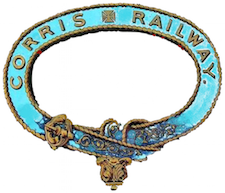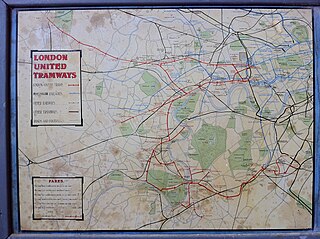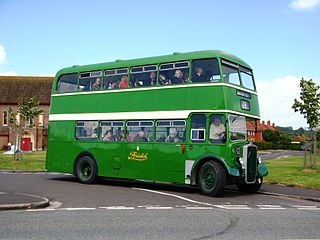Related Research Articles

The Corris Railway is a narrow gauge preserved railway based in Corris on the border between Merionethshire and Montgomeryshire in Mid-Wales.

The Imperial Order of the Crown of India is an order in the British honours system. The Order was established by Queen Victoria in 1878, when she became Empress of India and named after the Imperial Crown of India. The Order is open only to women and no additional appointments have been made since the Partition of India in 1947. The Order was limited to British princesses, wives or female relatives of Indian princes and the wife or female relatives of any person who held the office of:
There have been two separate generations of trams in London, from 1860 to 1952 and from 2000 to the present. There were no trams at all in London between 1952 and 2000.

The Melbourne cable tramway system was a cable car public transport system, which operated between 1885 and 1940 in Melbourne, Victoria, Australia.

Bristol Tramways operated in the city of Bristol, England from 1875, when the Bristol Tramways Company was formed by Sir George White, until 1941 when a Luftwaffe bomb destroyed the main power supply cables.

London United Tramways Company Limited was an operator of trams and trolleybuses in the western and southern suburbs of London, UK, from 1894 to 1933, when it passed to the London Passenger Transport Board.

The Newcastle Tram System was an extensive network that operated between Newcastle and the outer suburb of Wallsend from 1887–1950. At its peak the line extended from the city to Speers Point and West Wallsend. The service was rarely profitable, and low utilisation for a variety of reasons including the convenience of buses led to it closing and the tracks being removed.
Sir George White, 1st Baronet (1854–1916) was an English businessman and stockbroker based in Bristol. He was instrumental in the construction of the Bristol tramways and became a pioneer in the construction of electric tramways in England. In 1910 he formed, with his brother Samuel, the Bristol Aeroplane Company. He had many other interests, particularly in transport companies.

Sir (James) Clifton Robinson, born in Birkenhead, England, was known as the "Tramway King", having involvement in the building and operating of street tramways in New York City, London, Liverpool, Dublin, Cork, Bristol, Edinburgh and Los Angeles.

The Bristol Omnibus Company was a dominant bus operator in Bristol, and was one of the oldest bus companies in the United Kingdom. It ran buses over a wide area of Gloucestershire, Somerset, Wiltshire and neighbouring counties.

The Corris Railway's Grand Tour was a tourist service that ran between 1886 and 1930. It involved a journey on the Corris Railway, a charabanc connection to the Talyllyn Railway and a return via the Cambrian Railways line between Tywyn and Machynlleth.

Dublin tramways was a system of trams in Dublin, Ireland which commenced line-laying in 1871, and began service in 1872, following trials in the mid-1860s. Established by a number of companies, the majority of the system was eventually operated by forms of the Dublin United Tramways Company (DUTC), dominated for many years by William Martin Murphy. Most of the services ran within the city centre and near suburbs, with the majority of major suburbs served. Additionally, there were two longer-range services, one reaching the "excursion" destination of Poulaphouca Falls, and two services concerning Howth.
Gloucester Tramways Company operated a horse-drawn tramway service in Gloucester between 1879 and 1904.

Gloucester Corporation Tramways operated an electric tramway service in Gloucester between 1904 and 1933.

Tramways in Exeter were operated between 1882 and 1931. The first horse-drawn trams were operated by the Exeter Tramway Company but in 1904 the Exeter Corporation took over. They closed the old network and replaced it with a new one powered by electricity.
Middlesbrough Corporation Tramways operated an electric tramway service in Middlesbrough between 1921 and 1934.
The Middlesbrough and Stockton Tramways Company operated a horse-drawn tramway service in Middlesbrough between 1875 and 1898.
The Middlesbrough, Stockton and Thornaby Electric Tramways Company operated an electric tramway service between Middlesbrough, Thornaby-on-Tees, Stockton-on-Tees and Norton between 1898 and 1921.
Bradford Corporation Tramways were a tramway network in the city of Bradford, West Riding of Yorkshire, England which operated trams from 1882 until 1950 and trolleybuses from 1911 until 1972. The track gauge of the tramways was 4 ft.
The Melbourne tram network began in 1884 with the construction of the Fairfield Horse Tramway. However, the purpose of the line was to increase land prices in the area, and it soon closed during the depression in 1890. The first genuine attempt to construct a tramway network was the construction of the Richmond cable tram line by the Melbourne Tramway & Omnibus Company in 1885. Over the next few years, 16 more cable tram lines were constructed, as well as numerous other horse tramways. The depression of the early 1890s slowed further expansion of the cable network. The first electric tram line was the Box Hill and Doncaster tramway which opened in 1889. This was a pioneering line in what was then the countryside and thus didn't receive much patronage. It closed in 1896. The next attempt at an electric tramway was Victorian Railways' St Kilda to Brighton line, which opened in 1906. Later that year, the North Melbourne Electric Tramway and Lighting Company opened lines to Essendon and Maribyrnong. Many local councils formed their own tramway trusts and built tramways within their own constituency. The most successful of these was the Prahran and Malvern Tramway Trust.
References
- ↑ "Pictures: The days Teessiders were transported on trams". The Northern Echo. Retrieved 6 April 2020.
- London United Tramways, Geoffrey Wilson 1971
- Corris Railway Society Journal, 1992 & 1993